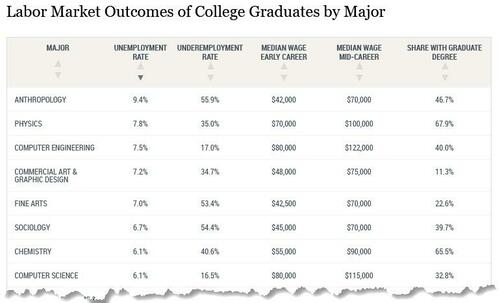
Computer Engineering Grads Face Double The Unemployment Rate Of Art History Majors
By Alexandra Horwitz of The College Fix
Computer engineering grads face double the unemployment rate of art history majors, according to the most recent data from the Federal Reserve Bank of New York.
The stats show art history majors have a 3 percent unemployment rate while computer engineering grads have a 7.5 percent unemployment rate. Computer science grads are in a similar boat, with a 6.1 percent rate.
The trend appears notable among STEM majors.
Graphic design is at 7.2 percent, chemistry at 6.1 percent and fine arts at 7.1 percent. Physics and sociology — which represent both sides of the spectrum — came in with similar numbers, with 7.8 percent and 6.7, respectively.
The highest on the list is anthropology at 9.4 percent. The lowest is nutritional sciences at .4 percent.

Asked to weigh in on the findings, economist Mark Perry, a University of Michigan Flint emeritus professor, said some STEM fields face a tougher labor market right now.
“One possible explanation for the higher-than-average jobless rates is that computer science majors face competition in the labor market from workers without a four-year degree but with work experience and from workers with a 2-year degree in computer science,” he told The College Fix.
He also said the required credentials, such as certifications, that computer science grads need to show future employers could be slowing things down for them.
Alex Beene, a financial literacy instructor for the University of Tennessee at Martin, expressed similar sentiments to Newsweek.
“Seeing such a high unemployment rate for majors like computer science may stun many Americans. After all, it’s been one of the most encouraged majors in recent years due to the unprecedented need in the field by many businesses,” he said.
“However, an abundance of those who major in a field doesn’t necessarily create more talent, and as many companies have developed more complex needs, they often want employees more skilled with a proven track record of success,” he said.
“As a result, some new graduates may find it more difficult than expected to obtain a job, especially in our current environment where some employers are scaling back.”
But not all STEM fields are struggling, Perry told The Fix.
“All of the engineering fields except industrial engineering (at 4.6%) have jobless rates at 2.4% or lower (civil, aerospace, mechanical, engineering technologies, chemical, electrical, general, etc.),” Perry said via email. “Engineering graduates also have very high salaries and very low rates of underemployment (about 20%).”
Georgetown University’s Professor Nicole Smith, chief economist of the university’s Center on Education and the Workforce, said that although STEM majors appear to be in high demand in the employment sector, their skill sets developed as undergraduates are less marketable than graduates of liberal arts schools.
Liberal arts majors, such as art history, have a “wider pool…they can sort their talent from,” Smith said. She said liberal arts majors can have “several other occupations [and] industries” to sell their skills within, an advantage not often available to STEM majors.
Perry noted the bank’s 2025 data relied on information from 2023, and the next set of data to be released in 2026 might paint a different picture.
“Labor market conditions are dynamic and change constantly, so the high jobless rates for computer science majors in 2023 may change,” he said.
Tyler Durden
Mon, 06/23/2025 – 08:05















